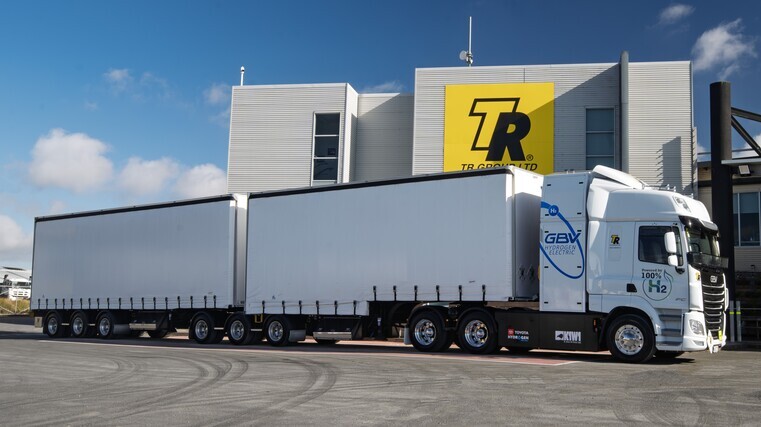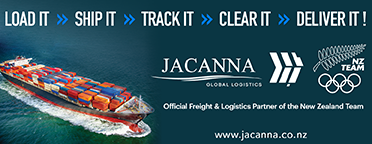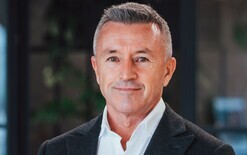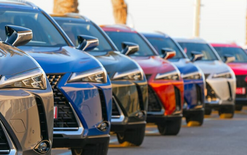Hydrogen take-off for transport

Toyota NZ is supporting the uptake of hydrogen in heavy transport via a partnership with TR Group, K1W1 and Global Bus Ventures (GBV).
The companies have launched a hydrogen-powered prime mover during a customer event at Hampton Downs Motorsport Park.
The truck, retrofitted as a fuel-cell electric vehicle (FCEV) thanks to a conversion by GBV, offers a zero-emissions solution for heavy freight transport.
The vehicle can operate with conventional trailers and loads, has comparable refuelling times with diesel, and will align with normal operator driving hours and schedules.
Able to operate like a conventional diesel truck, the 50-tonner is based on the DAF CF 530.
The truck’s energy comes from two Toyota 85kW fuel cells producing a total of 170kW, a 124kWh battery system and 52kg of onboard hydrogen storage.
It has been put through its paces during comprehensive road and track-testing and boasts a range of 450-500km depending on driver, routes and environmental conditions.
Power is delivered by a 350kW and 2400Nm electric motor paired with a six-speed gearbox, providing superior pulling power.
The truck forms part of a government-backed programme with Hiringa Energy, which will involve TR Group offering 20 hydrogen-powered trucks by way of fully maintained operating leases.
The latter will deploy four Hyundai Xcient FCEV rigid-chassis trucks as well as the 16 six-by-four “tractor units” supplied by the Christchurch-based GBV.
In total, this represents an investment in the tens of millions of dollars, with each vehicle to be offered at competitive lease rates.
Toyota NZ, which supplied the fuel cells for the truck, has been at the forefront of promoting hydrogen as a sustainable energy source by supporting the domestic hydrogen industry and pioneering applications of this technology across various sectors.
Its chief executive officer, Tatsuya Ishikawa, says Toyota’s ongoing work in this field aligns with its global commitment to carbon neutrality.
“From heavy-duty commercial vehicles and motorsports to hydrogen-powered marine vessels and off-grid generators, Toyota is demonstrating that hydrogen is more than just a fuel,” he explains. “It’s a key part of the clean-energy future.
“We continue to invest and collaborate with others in the hydrogen sector to help build a robust ecosystem that will benefit businesses and communities across the country.
“TR Group has significant scale in New Zealand’s trucking industry. We expect our partnership with it and GBV will see a substantial increase in the number of hydrogen-powered freight vehicles on Kiwi roads.
“Through our diverse efforts, Toyota NZ is bolstering the domestic hydrogen industry while demonstrating the versatility and potential of this technology in creating a sustainable energy landscape.”
Grant Doull, TR Group’s hydrogen fuel-cell truck project manager, says the vehicle leasing and rental company, which specialises in heavy trucks and trailers, has been on its decarbonisation journey for several years now.
It has more than 60 battery-electric trucks in addition to introducing New Zealand’s first commercial heavy hydrogen truck.
Doull says: “We are committed to supporting uptake of low-emissions technologies in the heavy-transport sector and through this project we’re taking a significant step towards demonstrating how hydrogen can play a key role in that.
“Collaboration across the industry, alongside the development of refuelling infrastructure, will be critical in making hydrogen a viable and scalable solution for New Zealand’s heavy-transport sector.”
GBV, meanwhile, has been producing heavy vehicles for more than 50 years and is renowned for its innovation when it comes to electric options.
It’s best known for introducing New Zealand’s first hydrogen heavy vehicle, the Auckland Transport hydrogen bus, and more recently for designing and supplying the hydrogen-electric power systems for the America’s Cup chase boats.
Mike Parker, executive vice-president of GVB, says: “This prime mover represents several years of R&D, making its launch into commercial operation a significant milestone for the company.”
TR Group’s general manager, Brendan King, adds: “We are delighted further to expand our hydrogen truck options for our customers. This includes 16 hydrogen 50-tonne prime movers, four Hyundai Xcient FCEV rigid-chassis trucks and CH2NGE dual-fuel truck options.”
The 20 hydrogen fuel-cell trucks are part of a government-supported programme alongside Hiringa Energy, which already has three hydrogen fuel stations and another under construction.
Andrew Clennett, co-founder of Hiringa Energy and its chief executive, says having a New Zealand-based truck integrator makes hydrogen more viable than ever.
“Hydrogen is ultra-fast, reliable and available now. The Hiringa refuelling network covers 95 per cent of North Island freight routes, allowing transport operators to reduce carbon emissions without impacting productivity.
“This meets growing customer demand for decarbonised supply chains. We congratulate TR Group and GBV on this milestone achievement and look forward to having these trucks on the network.”
Hyundai NZ says it’s delighted to continue its support of the increased use of hydrogen FCEV trucks in this country with an additional 4 Xcient heavy-duty trucks to complement the success of its truck, operated by NZ Post contractor Shea Transport.
With 180,000km already on the clock, the truck is operating seamlessly in NZ Post’s network and has already achieved 201 tonnes of carbon dioxide avoided to date.
As for Toyota, in 2022 it introduced the Mirai FCEV to New Zealand, demonstrating the potential of hydrogen as a clean alternative to traditional combustion engines with two of the vehicles being shared by eight corporate organisations as part of the Toyota Hydrogen Project.
Another is leased to Coregas NZ, while the company is planning to add 18 Mirais to a commercial fleet-leasing scheme.
Its hydrogen technology has also been adapted for maritime use. During the America’s Cup in Auckland in 2021 and Barcelona last year, Emirates Team NZ introduced the Chase Zero.
As the world’s first hydrogen-powered foiling chase boat, it utilises two Toyota fuel cells to generate electricity, propelling the boat to speeds of up to 35 knots with water as the only emissions.
Why green hydrogen?
Efficient heavy transport is about moving the most freight with the fewest trucks possible while staying within legal driving limitations.
TR Group says green hydrogen is the only zero-emissions solution that operates just like a diesel truck. A driver of a hydrogen truck can start a 12-hour shift, drive for five-and-a-half hours, take a break and then drive for another five-and-a-half hours.
With a quick 15-minute refuel as needed, a driver swap allows the cycle to repeat ensuring continuous, efficient operation.





